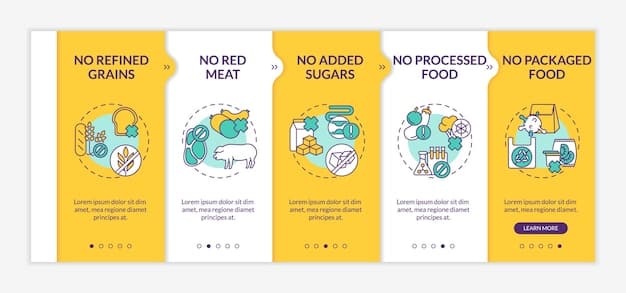The Truth About Sugar Substitutes: A 2025 US Health Expert Analysis

This 2025 analysis by US health experts delves into the evolving truth about sugar substitutes, scrutinizing their impact on long-term health, metabolic processes, and overall well-being, providing a comprehensive, evidence-based perspective for consumers and healthcare professionals.
For decades, sugar substitutes have promised a guilt-free sweet indulgence, a path to lower calorie intake without sacrificing flavor. Yet, as our understanding of nutrition and metabolic health evolves, so too does the narrative surrounding these ubiquitous ingredients. This deep dive, based on a 2025 US Health Expert Analysis, cuts through the noise to provide a nuanced, evidence-based perspective on the real impact of these sweeteners on your well-being. Are they truly the healthier alternative we once thought, or do their benefits come with unforeseen costs?
The Evolving Landscape of Sweeteners: From Artificial to Natural Alternatives
The quest for sweetness without the caloric burden of sugar has driven significant innovation in the food industry. What began with artificial sweeteners like saccharin and aspartame has expanded into a complex array of options, including sugar alcohols and novel natural-origin compounds. Understanding this evolution is key to discerning their place in a healthy diet.
Early artificial sweeteners, widely adopted in the mid-20th century, presented a revolutionary concept: intense sweetness with minimal to no calories. They enabled the creation of ‘diet’ versions of popular foods and beverages, seemingly offering a simple solution to managing weight and diabetes. However, their pervasive use sparked ongoing debates and scientific inquiry into their long-term effects.
Artificial Sweeteners: A Closer Look at the Classics
The established artificial sweeteners often include aspartame, saccharin, sucralose, and acesulfame potassium (Ace-K). Each has a unique chemical structure and sweetening mechanism, but they share the common characteristic of providing sweetness far greater than sugar, thus requiring only tiny amounts.
- Aspartame: Composed of two amino acids, aspartic acid and phenylalanine, aspartame is metabolized in the body. Concerns about its safety have largely been debunked by major health organizations, but some individuals with phenylketonuria (PKU) must avoid it.
- Saccharin: One of the oldest artificial sweeteners, saccharin has faced scrutiny over potential links to cancer, though extensive research in humans has not supported these claims. It’s often found in sugar-free gum and certain diet sodas.
- Sucralose: Derived from sugar but chemically modified, sucralose is heat-stable, making it popular in baked goods. It passes through the body largely undigested, contributing no calories.
Despite their established safety by regulatory bodies like the FDA, ongoing research continues to explore potential subtle effects on gut microbiota and metabolic responses, moving beyond the simple caloric equation.
The shift towards “natural” alternatives, such as stevia and monk fruit, reflects a consumer desire for ingredients perceived as less processed or derived from plant sources. These high-intensity sweeteners offer a similar zero-calorie sweetness profile but are often branded with a healthier halo, influencing market trends and consumer choices.
Understanding the nuances of these different sweetener categories is crucial for making informed dietary decisions, especially as new research emerges and the product landscape continues to expand. The discussion around their long-term health implications is far from settled, prompting a need for continuous evaluation based on the latest scientific evidence.
Beyond Calories: Metabolic Impacts and Gut Health
For years, the primary appeal of sugar substitutes revolved around their zero or low-calorie count, making them seem like a simple solution for weight management and blood sugar control. However, recent research transcends this simplistic calorie-in, calorie-out model, focusing on the intricate metabolic and physiological responses these compounds elicit. The scientific community is now particularly keen on understanding their influence on gut microbiota, glucose metabolism, and appetite regulation.
Studies have begun to reveal that the impact of non-nutritive sweeteners extends far beyond their energy value. Our bodies, particularly our digestive systems, react to these substances in ways that are still being fully elucidated. This has led to a paradigm shift in how health experts view their role in a balanced diet.
Gut Microbiota: The Unseen Connection
A significant area of interest is the relationship between sugar substitutes and the gut microbiome – the trillions of microorganisms residing in our intestines. Emerging research suggests that certain artificial sweeteners may alter the composition and function of these microbial communities. A disrupted gut microbiome has been linked to various health issues, including metabolic dysfunction, obesity, and even mood disorders.
- Dysbiosis Potential: Some studies indicate that sweeteners like sucralose and saccharin can lead to changes in gut bacteria, potentially shifting beneficial populations to less favorable ones.
- Metabolic Byproducts: Altered gut flora might produce different metabolic byproducts, influencing the host’s energy metabolism and insulin sensitivity in various ways.
- Individual Variability: It’s important to note that responses can vary significantly among individuals, likely influenced by pre-existing gut composition and genetic factors.
These findings, while often from animal studies or small human trials, point to a complex interplay that warrants more extensive, long-term research. The idea that common additives could subtly reshape our internal ecosystem is a compelling argument for prudence.

Beyond the gut, the direct metabolic effects are also under scrutiny. Some research suggests that even without directly contributing calories, intense sweeteners might influence insulin secretion, glucose tolerance, and satiety. The brain, perceiving sweetness, might prepare the body for a sugar load that never arrives, potentially leading to dysregulation of metabolic pathways over time.
For instance, some individuals report increased cravings or a feeling of dissatisfaction after consuming foods with sugar substitutes, which could counteract the intended benefit of calorie reduction. This phenomenon highlights a need for a more holistic approach to dietary advice, moving beyond calorie counting to consider the physiological and psychological responses to food components.
As health experts continue to analyze these intricate connections, the advice gravitates towards moderation and a focus on whole, unprocessed foods. While sugar substitutes can be a useful tool for some in specific contexts, they should not be seen as a universal panacea, particularly as we uncover their broader metabolic implications.
Weight Management: Do They Really Help?
The promise of sugar substitutes in weight management has been their most advertised benefit: enjoy sweetness without the calories, thus reducing overall caloric intake. For decades, diet beverages and sugar-free products were heralded as essential tools in the fight against obesity. However, the scientific consensus on their efficacy in long-term weight loss is far more nuanced and, in some cases, contradictory than initially presumed.
While replacing caloric sugar with non-caloric sweeteners theoretically leads to a calorie deficit, real-world data and longitudinal studies present a complex picture. Many studies have failed to show a consistent, significant long-term benefit for weight loss, and some even suggest potential associations with weight gain or increased waist circumference.
The Paradox of Sweetness
One prevailing theory behind this paradox is that artificial sweeteners might interfere with the body’s natural satiety mechanisms. Sweetness, without the corresponding caloric intake, could confuse the brain and digestive system, potentially leading to increased appetite and cravings for higher-calorie foods later on.
- Compensatory Eating: Individuals might subconsciously “compensate” for the calorie savings from diet products by eating more calories elsewhere in their diet, assuming they have “room” for extra indulgence.
- Altered Taste Perception: Regular consumption of intensely sweet substances might alter taste preferences, making less sweet, naturally nutritious foods (like fruits and vegetables) seem less appealing.
- Psychological Factors: The perception of consuming a “diet” product might also psychologically license individuals to consume more, undermining their weight management efforts.
Furthermore, the impact on gut microbiota, as discussed earlier, could play a role. A microbiome that is imbalanced by sweetener consumption might influence how calories are absorbed or how fat is stored, contributing to weight management challenges.
For example, some observational studies have shown correlations between regular consumption of diet sodas and increased risk of obesity and metabolic syndrome, though proving causation in such complex systems remains challenging. These studies often struggle to isolate the effects of sweeteners from other lifestyle factors and dietary patterns prevalent among diet beverage consumers.
Ultimately, a 2025 perspective from US health experts emphasizes that while sugar substitutes *can* be a tool for reducing sugar intake, they are not a magic bullet for weight loss. Effective weight management requires a holistic approach, focusing on whole, unprocessed foods, balanced macronutrient intake, portion control, regular physical activity, and addressing psychological factors related to eating. Relying solely on sugar substitutes without broader dietary and lifestyle changes is unlikely to yield sustainable weight loss and may even introduce unintended metabolic consequences.
Healthcare professionals are increasingly advising patients to prioritize water, unsweetened beverages, and naturally sweet foods like fruits, rather than routinely turning to artificially sweetened options as a primary strategy for calorie reduction. Moderation and mindful consumption remain key.
Navigating Diabetes: A Double-Edged Sword?
For individuals with diabetes, sugar substitutes have long been presented as a crucial dietary aid, offering a way to enjoy sweet tastes without spiking blood glucose levels. Their non-caloric nature makes them seem like an ideal replacement for sugar, which can directly impact glycemic control. However, a closer look at the 2025 expert analysis reveals that their role is more nuanced, potentially acting as a double-edged sword depending on the sweetener and individual metabolic response.
While they generally do not cause an immediate increase in blood sugar, ongoing research has raised questions about their long-term effects on glucose metabolism and insulin sensitivity, particularly when considering the gut microbiome’s influence.
Glycemic Control and Beyond
The primary benefit of sugar substitutes for diabetics is their minimal to non-existent impact on immediate blood glucose levels. This allows for wider dietary choices and can help reduce the overall glycemic load of meals and snacks.
- Immediate Impact: Most artificial sweeteners and sugar alcohols do not directly raise blood sugar or insulin levels shortly after consumption, making them a safer immediate alternative to sucrose.
- Sugar Alcohols Consideration: While sugar alcohols (like xylitol, erythritol) have fewer calories and a lower glycemic index than sugar, they can still have a minor impact on blood glucose, especially in larger quantities, and may cause digestive upset.
- Long-term Metabolic Effects: The concern shifts to their potential long-term effects. Studies exploring habitual consumption of certain non-nutritive sweeteners have suggested possible alterations in glucose tolerance or insulin sensitivity, though results are inconsistent and require further large-scale human trials.
One hypothesis explores how altering the gut microbiome could indirectly affect glucose metabolism. Changes in the microbial population might lead to reduced glucose absorption or altered production of gut hormones that regulate blood sugar. For instance, some research has indicated that saccharin, specifically, might induce glucose intolerance in certain individuals by changing their gut flora.
Furthermore, the “sweetness perception” phenomenon, where the brain anticipates a sugar load that doesn’t arrive, might play a role in metabolic confusion over time. This could theoretically lead to a blunted response to actual glucose, or paradoxically, increase insulin output without sufficient glucose uptake, contributing to insulin resistance over the long term.
For individuals with diabetes, the 2025 expert consensus emphasizes a cautious and individualized approach. While sugar substitutes can be part of a diabetic diet, they should not replace a foundational strategy of consuming whole, unprocessed foods, managing carbohydrate intake, and engaging in regular physical activity. Monitoring individual blood glucose responses to specific sweeteners is also recommended. Choosing plain water, unsweetened tea, or coffee remains the most advised beverage choice for blood sugar management.
The evolving advice underscores that sugar substitutes are a tool, not a cure, and their use in diabetes management should be integrated into a comprehensive, healthy lifestyle plan rather than relied upon as a primary intervention.
Understanding Safety & Regulatory Oversight in 2025
The safety of sugar substitutes is a recurrent topic of public discourse, often fueled by conflicting headlines and evolving scientific perspectives. In the US, the Food and Drug Administration (FDA) is the primary regulatory body responsible for ensuring the safety of food additives, including sugar substitutes. Their approval process is rigorous, requiring extensive toxicological and clinical data before a substance can be deemed “Generally Recognized As Safe” (GRAS) or approved for use.
As of 2025, the FDA maintains that the approved sugar substitutes are safe for human consumption within established acceptable daily intake (ADI) levels. However, the narrative is continually refined as new research emerges, particularly concerning long-term consumption patterns and subtle physiological effects that were not fully understood in earlier assessments.
Regulatory Frameworks and Ongoing Assessment
The FDA’s approach to sugar substitute safety relies on comprehensive evaluations, which include animal studies, human clinical trials, and epidemiological data. Each approved sweetener has an established ADI, a conservative estimate of the amount that can be consumed daily over a lifetime without adverse health effects.
- FDA Approval: All sugar substitutes currently on the US market have undergone an FDA approval process, signifying their safety under specific conditions of use.
- ADI Levels: Most adults would find it challenging to exceed the ADI for any approved sweetener through normal dietary consumption, thanks to their intense sweetness.
- Continuous Monitoring: Regulatory bodies, including the FDA, routinely review new scientific data and public health concerns to update their positions, ensuring that guidelines reflect the latest evidence.
Despite regulatory assurances, public apprehension often stems from historical controversies, such as the initial saccharin scares or ongoing debates about aspartame. While major health organizations like the World Health Organization (WHO), the American Diabetes Association (ADA), and the American Heart Association (AHA) generally support the safe use of approved sugar substitutes within ADI limits, they also advocate for an overall reduction in sweet tastes and processed foods.
The 2025 expert analysis also acknowledges the challenge of studying long-term effects in diverse populations. Observational studies, while useful for identifying associations, cannot definitively prove causation. Clinical trials, while establishing cause-and-effect, are often shorter-term and cannot fully replicate real-world dietary patterns over decades.

Moreover, the rise of “natural” high-intensity sweeteners like stevia and monk fruit has added another layer of complexity. While perceived as healthier due to their plant origin, they also undergo rigorous safety assessments and are held to the same standards as artificial compounds. Their “natural” label does not automatically equate to superior health benefits or absolute freedom from metabolic considerations.
In essence, while regulatory bodies declare sugar substitutes safe within prescribed limits, the 2025 expert perspective encourages informed consumption. This means respecting ADI levels, being mindful of overall dietary patterns, and prioritizing nutrient-dense, whole foods over heavily processed alternatives, regardless of their sweetener content. Continued vigilance and research are essential to adapt to new findings and ensure public health remains paramount.
Adopting a Balanced Perspective: Recommendations for 2025
As we navigate the evolving scientific landscape surrounding sugar substitutes, a balanced, informed perspective is crucial. The nuanced findings from the 2025 US Health Expert Analysis suggest that while these compounds can be a useful tool for some, they are not a universal solution for public health challenges like obesity or diabetes. Rather, their role is best understood within the context of an overall healthy dietary pattern.
The emphasis is shifting from viewing sugar substitutes as an unequivocally “better” alternative to traditional sugar, towards integrating them mindfully, as part of a larger strategy to reduce added sugar intake and foster healthier eating habits.
Practical Recommendations for Consumers
For individuals looking to make informed choices, the following recommendations, informed by the latest expert perspectives, can guide their approach to sugar substitutes:
- Reduce Overall Sweetness: The most impactful strategy for long-term health is to gradually reduce your palate’s expectation for intense sweetness. This includes both added sugars and high-intensity sweeteners. Enjoy the natural sweetness of fruits and vegetables.
- Prioritize Whole Foods: Build your diet around unprocessed or minimally processed foods – fresh fruits, vegetables, lean proteins, whole grains, and healthy fats. These foods offer essential nutrients and fiber, contributing to satiety and overall well-being.
- Read Labels Carefully: Be aware of the types of sweeteners in packaged foods and beverages. Recognize that “sugar-free” doesn’t automatically mean “healthy” or “calorie-free.”
- Hydrate with Water: Make plain water your primary beverage choice. Unsweetened teas and coffees are also excellent alternatives to sugary drinks, whether diet or regular.
- Mindful Moderation: If you choose to use sugar substitutes, do so in moderation. Occasional use for enjoyment is different from habitual reliance on them in every sweet item.
Instead of focusing solely on replacing sugar with substitutes, health experts advocate for a broader shift towards a diet that naturally contains less added sugar. This approach promotes a more diverse and nutrient-rich food intake, reducing reliance on all highly processed items, including those with artificial or natural high-intensity sweeteners.
For example, if you typically sweeten your coffee, try reducing the amount of sweetener gradually over time, or experiment with unsweetened options. If you enjoy soda, try sparkling water with a slice of lemon or lime instead of a diet soda. These small, consistent changes can lead to significant shifts in taste preferences and overall dietary quality.
Ultimately, the 2025 expert view on sugar substitutes is one of cautious optimism tempered by evolving scientific understanding. They can offer a bridge for some individuals seeking to reduce sugar intake, but they are not a substitute for a fundamentally healthy lifestyle. The journey towards better health is best paved with whole foods, mindful eating, and a decreased reliance on any form of isolated sweeteners.
| Key Point | Brief Description |
|---|---|
| 🔬 Metabolic Impact | New research questions beyond calorie-free, exploring effects on gut microbiota and glucose metabolism. |
| ⚖️ Weight Management | Efficacy is complex; some studies suggest no long-term benefit or even link to weight gain via compensatory eating. |
| 🩺 Diabetes & Health | Useful for immediate glycemic control, but long-term use needs caution due to potential metabolic alterations. |
| 🌿 Balanced View | Experts recommend reducing overall sweetness, prioritizing whole foods, and using substitutes in moderation. |
Frequently Asked Questions About Sugar Substitutes
▼
While all FDA-approved sugar substitutes are considered safe within specified acceptable daily intake (ADI) levels, they are not identical. Each has a unique chemical structure and metabolic pathway. Expert consensus highlights that individual responses can vary, and ongoing research continues to refine our understanding of their long-term health implications, emphasizing a need for vigilance.
▼
The scientific literature is mixed. While replacing caloric sugar with non-caloric sweeteners can reduce immediate calorie intake, studies have not consistently shown long-term weight loss benefits. Factors like compensatory eating, altered metabolic responses, and changes in gut microbiota might counteract the calorie savings, suggesting a complex interaction beyond simple arithmetic.
▼
Generally, non-nutritive sugar substitutes do not directly raise blood glucose or insulin levels. This makes them useful for immediate glycemic control in people with diabetes. However, 2025 expert analyses indicate possible subtle long-term metabolic effects and influence on gut health, which might indirectly impact glucose regulation. Moderation and individualized monitoring are still recommended.
▼
The “natural” label for stevia and monk fruit often influences consumer perception, but from a scientific perspective, their safety and metabolic impact are still under rigorous evaluation. While derived from plants, they are highly processed extracts. Current research suggests they share many characteristics with artificial sweeteners regarding their low-calorie profile, and all should be consumed in moderation as part of a balanced diet.
▼
US health experts in 2025 recommend a balanced approach focusing on reducing overall sweetness in the diet, whether from sugar or substitutes. Prioritize whole, unprocessed foods, drink plain water, and use sugar substitutes sparingly. They can be a tool to transition away from high sugar intake, but should not replace a foundational diet rich in natural, nutrient-dense foods.
Conclusion: A Nuanced Path Forward
The journey through the intricate world of sugar substitutes, guided by a 2025 US Health Expert Analysis, reveals a scientific landscape far more complex than a simple “good or bad” dichotomy. What began as a pursuit for guilt-free sweetness has matured into a nuanced understanding of their metabolic, physiological, and even psychological impacts. While regulatory bodies affirm their safety within established limits, the evolving science increasingly points towards a need for thoughtful consideration rather than unbridled enthusiasm. The consensus among leading health authorities is clear: sugar substitutes are a tool, not a panacea. Their most beneficial use lies in aiding a transition away from excessive added sugar, ultimately steering individuals towards a broader reduction in overall sweetness and a greater reliance on whole, unprocessed foods. This approach prioritizes not just calorie reduction, but a deeper engagement with the foundational principles of healthy eating, encouraging a palate that appreciates natural flavors and a diet that supports long-term well-being.





